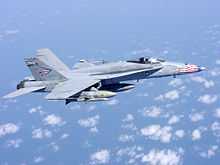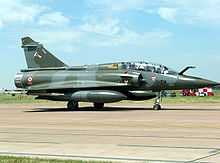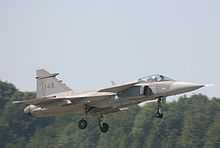Multirole combat aircraft

A multirole combat aircraft is a military aircraft intended to perform different roles in combat.[1] A multirole fighter is a multirole combat aircraft which is, at the same time, also a fighter aircraft; in other words, an aircraft whose various roles include, among others, the role of air-to-air combat.
History

The first use of the term was by the multinational European project named Multi-Role Combat Aircraft, which was formed in 1968 to produce an aircraft capable of tactical strike, air reconnaissance, air defense, and maritime roles.[citation needed] The design was aimed to replace a multitude of different types in the cooperating air forces. The project produced the Panavia Tornado, which used the same basic design to undertake a variety of roles, the Tornado IDS (Interdictor/Strike) variant and later the Panavia Tornado ADV (Air Defence Variant) variant.
Although the term "multirole aircraft" may be relatively novel, certain airframes in history have proven versatile to multiple roles. In particular the Ju 88 was renowned in Germany for being a "jack-of-all-trades", capable of performing as a bomber, dive bomber, fighter, night fighter, and so on, much as the British de Havilland Mosquito did as a fast bomber/strike aircraft, reconnaissance, and night fighter.
Multirole
The term has been reserved for aircraft designed with the aim of using a common airframe for multiple tasks where the same basic airframe is adapted to a number of differing roles. Originally the term was used for a common airframe built in a number of different variants for different roles. Multirole has also been applied to one aircraft with both major roles, for example:
- a primary air-to-air combat role
- a secondary role like air-to-surface attack.
More roles can be added, such as air reconnaissance, forward air control, and electronic warfare. Attack missions include the subtypes air interdiction, suppression of enemy air defense (SEAD), and close air support (CAS).
The main motivation for developing multirole aircraft is cost reduction in using a common airframe.
Swing-role
Some aircraft are called swing-role, to emphasize the ability of a quick role change, either at short notice, or even within the same mission. According to the Military Dictionary : "the ability to employ a multi-role aircraft for multiple purposes during the same mission."[2]
According to BAE Systems, "an aircraft that can accomplish both air-to-air and air-to-surface roles on the same mission and swing between these roles instantly offers true flexibility. This reduces cost, increases effectiveness and enhances interoperability with allied air forces".[3]
"Capability also offers considerable cost-of-ownership benefits to and operational commanders."[4]
Gallery
Active
| Country | Manufacturer | Aircraft | Introduced | Variants | |
|---|---|---|---|---|---|
| | Chengdu | J-10 | 2003 | J-10B |  |
| Dassault | Mirage 2000 | 1982 | N/D |  | |
| Rafale | 2000 |  | |||
| | HAL/Sukhoi | Sukhoi Su-30MKI | 1998 | .jpg) | |
| HAL | HAL Tejas | 2013 | Tejas Mark 2 |  | |
| | Mitsubishi | F-2 | 2000 | F-2A/B |  |
| | KAI | FA-50 | 2011 | _(4340109745).jpg) | |
| | PAC Chengdu | JF-17 Thunder | 2007 |  | |
| | Mikoyan | MiG-29 | 1983 | M, K |  |
| Sukhoi | Su-35 | 2008 | Su-35S |  | |
| | Saab | JAS 39 Gripen | 1997 |  | |
| | Panavia | Tornado IDS | 1979 | Tornado ADV | .jpg) |
| | Eurofighter | Typhoon | 2003 |  | |
| | General Dynamics (Lockheed Martin) | F-16 Fighting Falcon | 1978 |  | |
| McDonnell Douglas (Boeing) | F/A-18 Hornet | 1983 | F/A-18E/F Super Hornet |  |
See also
- Air superiority fighter
- Tactical bomber
- Interceptor aircraft
- Interdictor
- Fighter-bomber
- Attack aircraft
- Strike fighter
- Lead-in fighter trainer
References
- ↑ Military-Dictionary.org; both Wiktionary and Cambridge Dictionary only list "multirole", and not "multi-role".
- ↑ Definition Of: swing-role
- ↑ BAE SYSTEMS delivers Swing Role Radar capability to Eurofighter Typhoon
- ↑ Eurofighter Typhoon, Mission configuration, Swing Role
| |||||||||||||
| ||||||||||||||